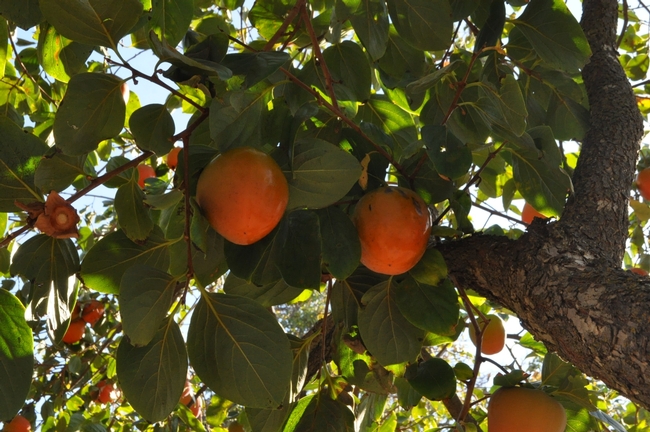Persimmons, A Colorful Fruit of the Late Autumn
Persimmons are one of the last fruits of the season and among the most colorful with dramatic autumn leaves and bright orange fruit. October is the month that persimmons ripen in our area and the fruit can be used in many ways from fresh or dried fruit to an ingredient of cookies, puddings or salads. The bright orange fruit also makes a colorful addition to autumn displays.
The species originated in central China and the persimmon cultivars commonly grown in California, Diospyros kaki spp., were originally cultivated in Japan. Between 1870 and 1920, the USDA introduced several Chinese and Japanese cultivars to the southern and western U.S. but now most persimmons are of the D. kaki species and are grown in the San Joaquin Valley. The native North American persimmon species, Diospyros virginica, is not found in California and the fruit is inferior to the cultivated species.
Persimmons are deciduous trees and the leaves turn dramatic colors in the autumn. The bright orange fruit will remain on the tree after the leaves fall creating a beautiful specimen for photography. The bark of a persimmon tree is deeply fissured with distinct rectangles. The species is in the ebony (Ebenaceae) family and persimmon wood and bark are dark. Persimmon trees are both colorful and drought resistant. but adequate water is required for an adequate fruit crop. Persimmons grow as a single or multi-stemmed tree and reach approximately 25 feet at maturity. Inconspicuous flowers are borne in the leaf axils of new growth from one-year old wood. Most cultivars are parthenocarpic. The set fruit remains inconspicuous and green until ripening to a bright orange fruit.
Persimmon trees are either male or female and sexual expression can vary from year to year. Most cultivars are parthenocarpic and set seedless fruit without pollination. Persimmons are classified into two general categories, those bearing fruit that is astringent until soft ripe and those whose fruit is not astringent; within each category are cultivars whose fruits are influenced by pollination (pollination variant) and those that are not (pollination constant). Fertilization of pollination variant cultivars results in the formation of seeds and fruit with a different flavor and texture than from non-pollinated fruit. Persimmon trees often set abundant fruit and although some self-thinning occurs in late spring, the largest fruit result from judicious hand thinning to one or two fruit per twig in May or June. Persimmons are easily planted as bare root trees in early winter and the two main cultivars grown in California are readily available from local and mail order nurseries.
Persimmons are relatively disease and pest free. The primary insect pests of persimmons are mealybug and scale in association with ants. Vertebrate pests including gophers and ground squirrels can scour roots and girdle trunk stems. The ripe fruits are a favorite of many vertebrates including squirrels, rats, opossums, deer and, of course, birds.
The two most widely grown cultivars in California are the astringent variety ‘Hachiya’ with oblong, conical fruit and the non-astringent variety ‘Fuyu’ with flat, faintly four-sided fruit. Astringent varieties can be harvested when fully colored but still hard and ripened at room temperature off the tree, or stored hard in the refrigerator for up to a month before being allowed to ripen. Although tree ripening will improve astringent fruit, birds will likely destroy the crop as it ripens fully. Non-astringent varieties can be harvested when fully colored and allowed to soften slightly off the tree. Non-astringent persimmons will soften significantly even when refrigerated when stored with other fruit.
Although astringent fruit must be jelly-soft before being edible, the soft fruit can be used in cookies, breads and puddings. The fruit contains considerable pectin and will add significant body to a smoothie! Non-astringent fruit can be eaten like an apple or added to autumn salads. All persimmons make excellent dried fruit and drying will remove the astringency from hard astringent fruit. Astringent fruit can be dried by hanging from the stem, either peeled or unpeeled and results is a sweet date-like confection.
Persimmons should be harvested by cutting the stem with hand shears, leaving he calyx intact. The stem should be cut close to the calyx unless a short piece of stem is required for drying. Harvested fruit should be handled with care, even if hard, to prevent bruising.
References:
UC Davis Fruit and Nut Research and Information Website for Persimmons (2013)
http://fruitandnuteducation.ucdavis.edu/education/fruitnutproduction/Persimmon/
Pomegranate Fruit Facts (1996) - California Rare Fruit Growers
http://www.crfg.org/pubs/ff/persimmon.html

Beautiful orange persimmon ornaments. (photo by Rich Zimmerman)


Posted by Lorain Huey on October 27, 2015 at 9:30 PM